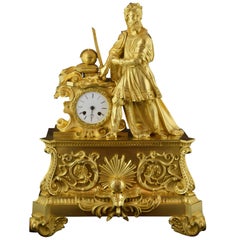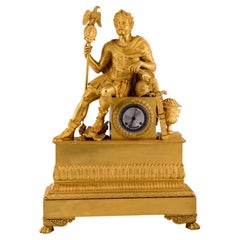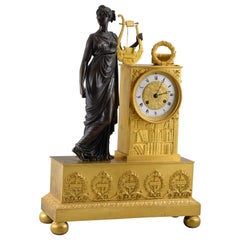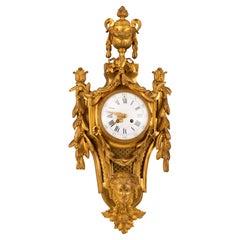Want more images or videos?
Request additional images or videos from the seller
1 of 7
Table Clock Ormolu Bronze Signed Dumont, Paris, 19th Century
$7,042.30List Price
About the Item
- Dimensions:Height: 19.3 in (49 cm)Width: 13.78 in (35 cm)Depth: 4.73 in (12 cm)
- Style:Neoclassical (Of the Period)
- Materials and Techniques:
- Place of Origin:
- Period:
- Date of Manufacture:19th Century
- Condition:Wear consistent with age and use.
- Seller Location:Madrid, ES
- Reference Number:Seller: Zf0125 1stDibs: LU295139170841
About the Seller
4.8
Vetted Professional Seller
Every seller passes strict standards for authenticity and reliability
Established in 1985
1stDibs seller since 2017
351 sales on 1stDibs
Typical response time: 17 hours
Authenticity Guarantee
In the unlikely event there’s an issue with an item’s authenticity, contact us within 1 year for a full refund. DetailsMoney-Back Guarantee
If your item is not as described, is damaged in transit, or does not arrive, contact us within 7 days for a full refund. Details24-Hour Cancellation
You have a 24-hour grace period in which to reconsider your purchase, with no questions asked.Vetted Professional Sellers
Our world-class sellers must adhere to strict standards for service and quality, maintaining the integrity of our listings.Price-Match Guarantee
If you find that a seller listed the same item for a lower price elsewhere, we’ll match it.Trusted Global Delivery
Our best-in-class carrier network provides specialized shipping options worldwide, including custom delivery.You May Also Like
19th Century Ormolu Gilt Bronze Antique Table Clock
Located in Casale Monferrato, IT
Rare antique 19th century table clock in ormolu gilt bronze. Characterized by a refined decoration chiseled in bronze, in the upper part a s...
Category
Antique 1880s Italian Table Clocks and Desk Clocks
Materials
Bronze
$2,629 Sale Price
20% Off
H 18.12 in W 11.82 in D 5.12 in
19th Century French Bronze and Ormolu Clock
By Claude Galle
Located in Scottsdale, AZ
19th Century French Bronze and Ormolu Clock. circa 1810 clock Napoleonic Empire Bronze Dore. La Liseuse" clock after Reiche, by Claude Galle & Grand Girad. Signed in Paris
Category
Antique Mid-19th Century French Napoleon III Table Clocks and Desk Clocks
Materials
Bronze
French 19th Century Louis XVI Style Ormolu Clock Signed 'Raingo Freres, Paris
By Zacharie Raingo
Located in West Palm Beach, FL
An exceptional and very high quality French 19th century Louis XVI st. ormolu and patinated bronze clock, signed Raingo Frères Paris. The clock is ...
Category
Antique 19th Century French Louis XVI Mantel Clocks
Materials
Bronze, Ormolu
$7,600
H 15.5 in W 9.25 in D 5.5 in
Large 19th Century Gilded Ormolu and Bronze Clock Set, by Deniere, Paris
By Maison Deniere
Located in Brighton, Sussex
A large and impressive 19th century gilded ormolu and bronze Louis XVI style clock garniture, having a reclined classical lady reading, next to a white enamel clock face with an eigh...
Category
Antique 19th Century French Louis XIV Mantel Clocks
Materials
Marble, Bronze, Ormolu
$26,647 / set
H 20.08 in W 27.56 in D 8.27 in
Large 19th Century Louis XVI Style Bronze Ormolu Mantel Clock Guibal Paris
Located in Casteren, Noord-Brabant
A fine and large Louis XVI style French mantel clock, from the end of the Napoleon III period, 1870-1880. The clock is bronze casted and has a fire-gilded finish, the dial is enamele...
Category
Antique 1870s French Louis XVI Mantel Clocks
Materials
Brass, Bronze, Enamel, Ormolu
$6,924
Free Shipping
H 20.08 in W 16.15 in D 9.06 in
19th Century French Bronze and Ormolu Clock Garniture
By A.D. Mougin
Located in London, GB
A fine quality late 19th century French bronze and ormolu garniture, the 8-day striking enamelled dial movement by AD Mougin - Paris, contained in ormolu cas...
Category
Antique Late 19th Century French More Clocks
Materials
Marble, Bronze, Ormolu
19th Century Gilded Ormolu and Bronze Mantel Clock
Located in Brighton, Sussex
An impressive late 19th century French gilded ormolu and patinated bronze mantel clock. Having three putti mounted to the top each playing musical instruments. The clock having an ei...
Category
Antique Late 19th Century French Louis XVI Mantel Clocks
Materials
Bronze, Ormolu
French 19th Century Neo-Classical Period Marble, Ormolu, & Bronze Clock
Located in West Palm Beach, FL
A beautiful and finely detailed French 19th century Neo-Classical period Alabaster, Ormolu, Sainte-Anne Grand Dessin marble, and patinated Bronze annu...
Category
Antique 19th Century French Neoclassical Table Clocks and Desk Clocks
Materials
Marble, Bronze, Ormolu
$38,500
H 27.5 in W 10.5 in D 10 in
19th Century French Empire Bronze & Ormolu Egyptian Style Clock Clock
Located in London, GB
A French Empire bronze and ormolu clock in the Egyptian style with 8 day silk-suspension striking movement by Hemon a Paris, also marked “Ledure Bronzier”, enclosed in bronze obelisk...
Category
Antique 19th Century French Egyptian Clocks
Materials
Bronze
$5,062
H 17.5 in W 8 in D 4.5 in
French Early 19th Century Louis XVI Style Ormolu Clock, 'Signed Lepaute Paris'
Located in West Palm Beach, FL
An extremely high quality French mid 19th century Louis XVI st. signed 'Lepaute, Paris' ormolu clock. The clock with a superb chasing throughout has all of its original gilt. Raised ...
Category
Antique 19th Century French Louis XVI Mantel Clocks
Materials
Ormolu
$18,900
H 17.5 in W 10 in D 6.5 in
More From This Seller
View AllTable Clock, Ormolu, 19th Century
Located in Madrid, ES
Table clock made of gilded bronze with a powerful base, enhanced with legs decorated with vegetal and architectural motifs of classicist inspiration and a series of details on the fr...
Category
Antique 19th Century European Neoclassical Mantel Clocks
Materials
Bronze
Table clock, Aníbal Barca. Ormolu bronze, metal. France, 19th century.
Located in Madrid, ES
Table clock, Aníbal Barca. Ormolu bronze, metal. France, 19th century.
Table clock with Paris machinery and a case made of mercury-gilded bronze. in mercury-gilded bronze, with a rectangular base on four rectangular base on four legs (the front ones decorated with scrolls and decorated with scrolls and ending in claws), decorated with a series of mouldings in relief with vegetal and architectural elements. vegetal and architectural elements in relief. The dial The dial (metal with Roman numerals for the hours) is set within a square shape, on which sits the male figure that decorates the piece. A bearded man, dressed in armour (a muscular loriga or cuirass) and a cape fixed over one shoulder with a fibula, resting his left arm on the helmet holding a rolled-up document, and with his left hand document, and with his left hand he holds a Roman standard (another Roman standard (another is broken, under his foot). Note, to the right and next to a sword, a vase full of rings.
vase full of rings.
Hannibal Barca (247-183 BC) was a Carthaginian general and statesman who was well known for his Carthaginian general and statesman, well known for his the ancient Roman Empire. No He was often depicted as counting the rings of fallen Roman knights in
the fallen Roman knights at the battle of Cannas (216 BC). , as can be seen in the sculpture by
sculpture by Sébastien Slodtz (made in 1704, Louvre Museum, Paris), where he also carries a Roman banner. Roman standard. With these two elements (vase with rings and with rings and a banner) is also shown on a table clock...
Category
Antique 19th Century European Neoclassical Revival Mantel Clocks
Materials
Bronze, Other
Table clock with Muse and writers. Bronze, Paris movement. France, 19th century.
Located in Madrid, ES
Table clock with Muse and writers. Blued and gilded bronze, Paris movement. France, 19th century.
Perfectly working mechanism.
Table clock in blued and gilt bronze with Paris mac...
Category
Antique 19th Century French Neoclassical Revival Mantel Clocks
Materials
Bronze, Other
Wall clock. Gilt bronze. France, 19th century.
Located in Madrid, ES
Wall clock. Gilt bronze. France, 19th century.
Gilt bronze wall clock of the type known as a "cartel" due to its shape, featuring Parisian movement and a white dial with Roman numer...
Category
Antique 19th Century French Neoclassical Revival Wall Clocks
Materials
Bronze, Other
Clock and candelabra garniture. Paris, France, second half 19th century.
By Raingo Frères
Located in Madrid, ES
Clock and candelabra trim. Blued and gilded bronze, marble. Raingo Frères, Aaria, Clodion. Paris, France, second half of the 19th century.
Working.
The two candelabras follow a model highly appreciated in the 19th century of a bronze figure of a bacchante (a common figure in the procession of the classical god...
Category
Antique 19th Century French Neoclassical Revival Mantel Clocks
Materials
Marble, Bronze, Other
Garniture, clock and candelabra. Bronze, porcelain. France, 19th century.
Located in Madrid, ES
Garnish with clock and candelabra in porcelain and gilt bronze. France, 19th century.
Mechanism in perfect working order.
Fireplace garnish composed of a clock and two five-light candelabras, all three pieces made by combining gilt bronze, with relief elements and round bulges and cold-chiseled details, and porcelain decorated with low-temperature enamels, including gold enamel. The porcelain pieces follow models from the Sèvres National Manufacture of the 18th century, with large pictorial cartouches on a cobalt blue background adorned with golden plant motifs. The set follows a historicist design that combines baroque and neoclassical elements with enamelled scenes of Rococo inspiration, representing landscapes and scenes with mythological themes alluding to the arts and the goddess Venus. The clockwork is stamped “Chles. MT”, with serial number 17420. The main glazed porcelain plates are signed DP Boncher. The clock follows an architectural structure, with an oval base with a prominent front in plan, raised on four molded feet in the shape of a top, on which a large ornamental vase is placed. This plinth has a distinct pinto and, above it, a main body as a façade, with a circular pediment that houses the clock face. This includes black enamelled Roman numerals on white medallions with a gold border, arranged around the central representation of a putti reclining among clouds, holding a floral garland and accompanied by musical instruments. Among the medallions that house the numbers, a small jeweled decoration that evokes pearls and embedded rubies, which is echoed in the secondary areas of the body of the piece and also the vase, always combined with delicate golden filigrees.
On both sides of the sphere are two female portraits of ladies from the 18th century, in oval frames. Below, a classically inspired scene with a muse holding musical instruments, probably Euterpe or Erató, accompanied by a putti reading a sheet of music. On the sides of the clock body, two large curved rectangular plates house highly pictorial enameled landscapes, worked with the same miniaturist precision as the rest of the enameled cartouches. These are landscapes of romantic heritage, again inspired by the 18th century, with ideal settings for a twilight atmosphere, featuring classical ruins. The vase that tops the body of the clock has a hemispherical tank, shoulders ending in an edge, an openwork truncated conical neck, which opens smoothly towards the shoulders, and a domed lid, also openwork. The handles are figurative, in bronze, with two female sisters crowned with flowers, of clear Greco-Latin inspiration, worked in a round shape. In the tank, the vase houses two enameled porcelain cartouches, the front one with two putti and a dove - a symbolic allusion to Venus - and the back one with musical instruments. The design of the clock is completed by two thick bronze S-shaped plant braces, under the vase, and counter moldings and plant motifs cast in relief and cold chiseled, combining matte and polished finishes. The candelabras follow a similar design, with large vases of neoclassical design on pedestals, in this case cylindrical, raised on four low feet of turned design. The bases house porcelain cartouches with scenes of putti related to the arts; In one of them we see two putti practicing painting, and in the other two others in a scene related to classical lyric poetry, with one putto writing while the other, holding a lyre, raises a laurel wreath above his head. The cartouches that occupy the front of the candelabra vases...
Category
Antique 19th Century French Neoclassical Revival Mantel Clocks
Materials
Metal, Bronze, Other



